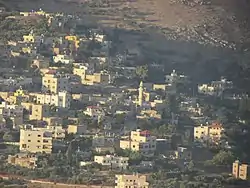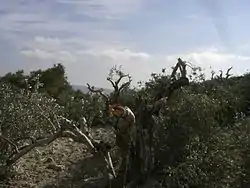Burin, Nablus
Burin (Arabic: بورين) is a Palestinian village in the Nablus Governorate in northern West Bank, located 7 kilometres (4.3 mi) southwest of Nablus. The town had a population of around 2,800 in 2008.
Burin | |
|---|---|
| Arabic transcription(s) | |
| • Arabic | بورين |
 View of Burin, 2014 | |
 Burin Location of Burin within Palestine | |
| Coordinates: 32°11′03″N 35°14′59″E | |
| Palestine grid | 173/176 |
| State | State of Palestine |
| Governorate | Nablus |
| Government | |
| • Type | Municipality |
| Population (2008) | |
| • Total | 2,800 |
| Name meaning | from the Arab word for pit?[1] |
| Website | www.burin.org.ps |
History
The name itself may conserve the toponym of Beera mentioned in the Book of Judges 9:21.[2]
In the 12th and 13th centuries, during the Crusader era, Burin was inhabited by Muslims, according to Ḍiyāʼ al-Dīn. The founder of the Banu Ghawanima family was born in the village in 1166.[3][4]
In 1176, a part of the tithes from the village was pledged to the Church of Mount Zion, but there is no evidence that it was ever collected.[5]
Ottoman era
Burin was incorporated into the Ottoman Empire in 1517 with all of Palestine, and in 1596 it appeared in the tax registers as being in the nahiya of Jabal Qubal, part of the Nablus Sanja. It had a population of 120 households and 5 bachelors, all Muslim. They paid a fixed tax rate of 33.3% on a number of crops, including wheat, barley, summer crops, olives, and goats or beehives, and a press for olives or grapes; a total of 26,445 akçe.[6] The family of the Damascene scholar al-Hasan al-Burini (d. 1615) hailed from Burin.[7]
In 1838, it was noted as Baurin, located in Jurat Amra, south of Nablus.[8] Robinson further noted that it was "a large village, or rather a market town."[9]
In 1882, the PEF's Survey of Western Palestine described Burin as a "large village in a valley, with a spring in the middle and a few olives."[10]
British Mandate era
In the 1922 census of Palestine conducted by the British Mandate authorities, Burin had a population of 901, all Muslims,[11] while in the 1931 census it had 215 houses and a population of 859 Muslims.[12]
In the 1945 statistics, Burin (with Iraq Burin) had a population of 1,200, all Muslims,[13] with 19,096 dunams of land, according to an official land and population survey.[14] Of this, 1,797 dunams were plantations and irrigable land, 8,741 used for cereals,[15] while 106 dunams were built-up (urban) land.[16]
Jordanian era
In the wake of the 1948 Arab–Israeli War, and after the 1949 Armistice Agreements, Burin came under Jordanian rule.
The Jordanian census of 1961 found 2,068 inhabitants in Burin.[17]
Post-1967
Since the Six-Day War in 1967, Burin has been under Israeli occupation.
After the 1995 accords, 20% of the village land was classified as Area B, the remaining 80% as Area C.[18] Israel has confiscated land from Burin in order to construct 2 Israeli settlements: 621 dunams for Bracha, and 233 dunams for Yizhar.[19]
Demographics
According to the Palestinian Central Bureau of Statistics (PCBS), the town had a population of 2,573 inhabitants in mid-year 2006.[20] The town had a population of around 2,800 in 2008.[21]
Expropriation and settler violence
The land and water resources of Burin has gradually been reduced since the 1967 Israeli occupation, due to the expropriation for Israeli settlements and military bases. Since 1982, more than 2,000 dunams of Burins land was first declared "state land" and then handed over to the settlers of Har Brakha.[24]
In 2008, a yeshiva student from Yitzhar was arrested after a failed rocket attack on Burin.[25] After Israeli police demolished a trailer home in Adei Ad, a group of settlers from Yitzhar vandalized cars, smashed windows and cut electricity wires in Burin.[26][27] From mid-June 2008 to August 2008 the human rights group Yesh Din documented nine attacks on Palestinian families living in Burin allegedly carried out by settlers living in outposts near Yitzhar or Har Brakha.[28] Cases of "disturbances of the peace", a term referring to harm caused to Palestinians and their property, as well as harm to Israeli security forces, by Israeli citizens, rose in 2008, with 429 incidents in the first half of 2008, compared with 587 incidents in all of 2006 and 551 in 2007.[29]
In February 2010, an 18-year-old Burin resident was shot and wounded by a settler security guard, which the settlers said took place after Palestinians threw stones at them.[30]
There has been several attacks from Israeli settlers on olive trees in Burin.[21][31][32][33]
Olive harvest days are coordinated with Israel, the Palestinian Authority and large clans in the area to prevent violence and vandalism. 7,714 Palestinian-owned trees were damaged during the first months of 2013. According to a report by Yesh Din, Burin had lost the most trees. A spokesman for the Israeli governing body in the West Bank said that were also cases where Palestinians has damaged trees owned by Israel, but they were fewer.[34]
See also
References
- Palmer, 1881, p. 181
- Israel Finkelstein and Oded Lipschits, 'Geographical and Historical Observations on the old North Israelite Gideon tale in Judges,' Zeitschrift für die Alttestamentliche Wissenschaft 2017; 129(1): 1–18 p.13
- Ellenblum, 2003, pp. 244, 263
- Moudjir ed-dyn, 1876, p. 133
- Röhricht, 1893, RHH, pp. 153 -154, No. 576; cited in Ellenblum, 2003, p. 224
- Hütteroth and Abdulfattah, 1977, p. 132.
- Mullazadih 2013, p. 45.
- Robinson and Smith, 1841, vol 3, Appendix 2, p. 127
- Robinson and Smith, 1841, vol 3, p. 94
- Conder and Kitchener, 1882, SWP II, p. 162
- Barron, 1923, Table IX, Sub-district of Nablus, p. 24
- Mills, 1932, p.60
- Government of Palestine, Department of Statistics, 1945, p. 18
- Government of Palestine, Department of Statistics. Village Statistics, April, 1945. Quoted in Hadawi, 1970, p. 59
- Government of Palestine, Department of Statistics. Village Statistics, April, 1945. Quoted in Hadawi, 1970, p. 105
- Government of Palestine, Department of Statistics. Village Statistics, April, 1945. Quoted in Hadawi, 1970, p. 155
- Government of Jordan, Department of Statistics, 1964, p. 15
- Burin Village Profile ARIJ, p. 17
- Burin Village Profile ARIJ, p. 18
- Projected Mid -Year Population for Nablus Governorate by Locality 2004- 2006 Palestinian Central Bureau of Statistics
- Confiscation of more Palestinian Lands in Burin village for the expansion of Bracha Settlement Archived December 3, 2013, at the Wayback Machine 1 May 2009, ARIJ
- "Palestinians say dozens of trees cut down by settlers". Ynet. 2009-11-12.
- "Settlers chop down olive trees south of Nablus". Ma'an. 2009-11-12.
- How dispossession happens. The humanitarian impact of the takeover of Palestinian springs by Israeli settlers Archived 2014-02-24 at the Wayback Machine, March 2012, United Nations Office for the Coordination of Humanitarian Affairs occupied Palestinian territory
- Ha'aretz Settler arrested in failed rocket attack on Palestinian town. retrieved 26 July 2008
- Ha'aretz Settler holds knife to IDF soldier's throat in West Bank riot. retrieved 26 July 2008
- Arutz Sheva Police Violence in Yitzhar, Locals Complain to AG retrieved 26 July 2008
- Special feature / The land of unchecked settler harassment 15 August 2008, Avi Issacharoff, Ha'aretz
- Ha'aretz 15 August 2008 Behind closed doors, police admit "turning a blind eye" to settler violence By Uri Blau
- Saed Bannoura, IMEMC News, Feb. 10, 2010
- Burin olive orchards under settlers' attack 29, December, 2005, ARIJ Archived December 3, 2013, at the Wayback Machine
- "Setting 1200 Olive Trees Alight in Burin village – Nablus Governorate 17, July, 2011, ARIJ". Archived from the original on 2015-09-24. Retrieved 2014-06-11.
- Ravaging 17 Olive Trees in Khallet Siwar, Burin Village - Nablus Governorate 11, May, 2012, ARIJ Archived December 3, 2013, at the Wayback Machine
- In a harvest, Palestinians cast a light on hardship, Jodi Rudoren, Oct. 22, 2013, The New York Times
Bibliography
- Barron, J.B., ed. (1923). Palestine: Report and General Abstracts of the Census of 1922. Government of Palestine.
- Conder, C.R.; Kitchener, H.H. (1882). The Survey of Western Palestine: Memoirs of the Topography, Orography, Hydrography, and Archaeology. 2. London: Committee of the Palestine Exploration Fund.
- Ellenblum, Ronnie (2003). Frankish Rural Settlement in the Latin Kingdom of Jerusalem. Cambridge University Press. ISBN 9780521521871.
- Government of Jordan, Department of Statistics (1964). First Census of Population and Housing. Volume I: Final Tables; General Characteristics of the Population (PDF).
- Government of Palestine, Department of Statistics (1945). Village Statistics, April, 1945.
- Hadawi, S. (1970). Village Statistics of 1945: A Classification of Land and Area ownership in Palestine. Palestine Liberation Organization Research Center.
- Hütteroth, Wolf-Dieter; Abdulfattah, Kamal (1977). Historical Geography of Palestine, Transjordan and Southern Syria in the Late 16th Century. Erlanger Geographische Arbeiten, Sonderband 5. Erlangen, Germany: Vorstand der Fränkischen Geographischen Gesellschaft. ISBN 3-920405-41-2.
- Mills, E., ed. (1932). Census of Palestine 1931. Population of Villages, Towns and Administrative Areas. Jerusalem: Government of Palestine.
- Mullazadih, Muhammad Hani (2013). "Al-Burini, Hasan ibn Muhammad Dimashqi Saffuri". In Adel, Gholamali Haddad; Elmi, Mohammad Jafar; Taromi-Rad, Hassan (eds.). Historians of the Islamic World: Selected Entries from Encyclopedia of the World of Islam. London: EWI Press. pp. 45–48. ISBN 978-1-908433-12-1.
- Moudjir ed-dyn (1876). Sauvaire (ed.). Histoire de Jérusalem et d'Hébron depuis Abraham jusqu'à la fin du XVe siècle de J.-C. : fragments de la Chronique de Moudjir-ed-dyn.
- Palmer, E.H. (1881). The Survey of Western Palestine: Arabic and English Name Lists Collected During the Survey by Lieutenants Conder and Kitchener, R. E. Transliterated and Explained by E.H. Palmer. Committee of the Palestine Exploration Fund.
- Robinson, E.; Smith, E. (1841). Biblical Researches in Palestine, Mount Sinai and Arabia Petraea: A Journal of Travels in the year 1838. 3. Boston: Crocker & Brewster.
- Röhricht, R. (1893). (RRH) Regesta regni Hierosolymitani (MXCVII-MCCXCI) (in Latin). Berlin: Libraria Academica Wageriana.
External links
- Welcome To Burin
- Survey of Western Palestine, Map 11: IAA, Wikimedia commons
- Burin Council
- Burin Village Profile, Applied Research Institute–Jerusalem (ARIJ)
- Burin (aerial photo), ARIJ
- Development Priorities and Needs in Burin, ARIJ
- Burin olive orchards under settlers' attack 29, December, 2005, POICA
- Confiscation of more Palestinian Lands in Burin village for the expansion of Bracha Settlement 01, May, 2009, POICA
- Setting 1200 Olive Trees Alight in Burin village – Nablus Governorate 17, July, 2011, POICA
- Ravaging 17 Olive Trees in Khallet Siwar, Burin Village - Nablus Governorate 11, May, 2012, POICA
- Burin
- Burin

